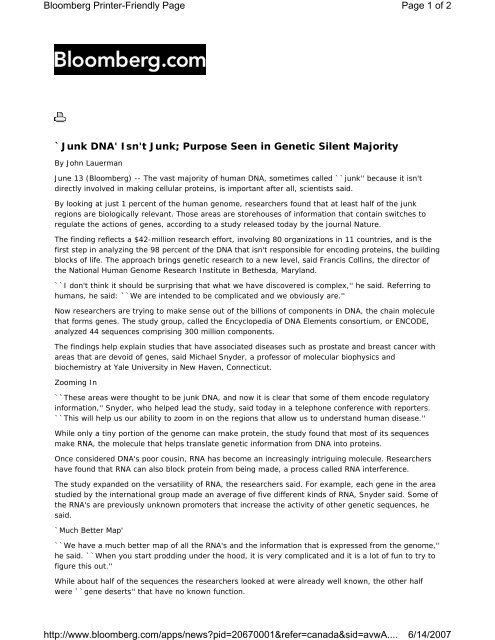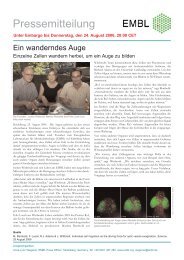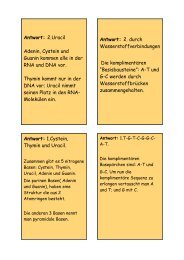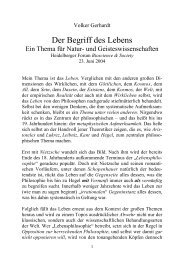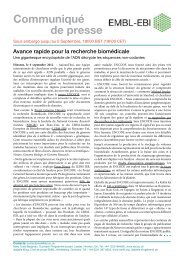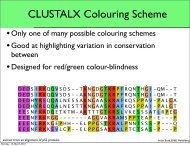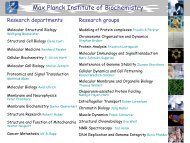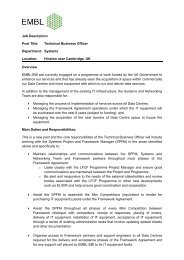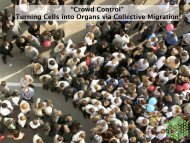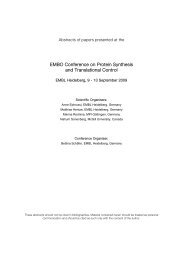Media Clips - EMBL
Media Clips - EMBL
Media Clips - EMBL
Create successful ePaper yourself
Turn your PDF publications into a flip-book with our unique Google optimized e-Paper software.
Bloomberg Printer-Friendly Page<br />
`Junk DNA' Isn't Junk; Purpose Seen in Genetic Silent Majority<br />
By John Lauerman<br />
June 13 (Bloomberg) -- The vast majority of human DNA, sometimes called ``junk'' because it isn't<br />
directly involved in making cellular proteins, is important after all, scientists said.<br />
By looking at just 1 percent of the human genome, researchers found that at least half of the junk<br />
regions are biologically relevant. Those areas are storehouses of information that contain switches to<br />
regulate the actions of genes, according to a study released today by the journal Nature.<br />
The finding reflects a $42-million research effort, involving 80 organizations in 11 countries, and is the<br />
first step in analyzing the 98 percent of the DNA that isn't responsible for encoding proteins, the building<br />
blocks of life. The approach brings genetic research to a new level, said Francis Collins, the director of<br />
the National Human Genome Research Institute in Bethesda, Maryland.<br />
``I don't think it should be surprising that what we have discovered is complex,'' he said. Referring to<br />
humans, he said: ``We are intended to be complicated and we obviously are.''<br />
Now researchers are trying to make sense out of the billions of components in DNA, the chain molecule<br />
that forms genes. The study group, called the Encyclopedia of DNA Elements consortium, or ENCODE,<br />
analyzed 44 sequences comprising 300 million components.<br />
The findings help explain studies that have associated diseases such as prostate and breast cancer with<br />
areas that are devoid of genes, said Michael Snyder, a professor of molecular biophysics and<br />
biochemistry at Yale University in New Haven, Connecticut.<br />
Zooming In<br />
``These areas were thought to be junk DNA, and now it is clear that some of them encode regulatory<br />
information,'' Snyder, who helped lead the study, said today in a telephone conference with reporters.<br />
``This will help us our ability to zoom in on the regions that allow us to understand human disease.''<br />
While only a tiny portion of the genome can make protein, the study found that most of its sequences<br />
make RNA, the molecule that helps translate genetic information from DNA into proteins.<br />
Once considered DNA's poor cousin, RNA has become an increasingly intriguing molecule. Researchers<br />
have found that RNA can also block protein from being made, a process called RNA interference.<br />
The study expanded on the versatility of RNA, the researchers said. For example, each gene in the area<br />
studied by the international group made an average of five different kinds of RNA, Snyder said. Some of<br />
the RNA's are previously unknown promoters that increase the activity of other genetic sequences, he<br />
said.<br />
`Much Better Map'<br />
``We have a much better map of all the RNA's and the information that is expressed from the genome,''<br />
he said. ``When you start prodding under the hood, it is very complicated and it is a lot of fun to try to<br />
figure this out.''<br />
While about half of the sequences the researchers looked at were already well known, the other half<br />
were ``gene deserts'' that have no known function.<br />
http://www.bloomberg.com/apps/news?pid=20670001&refer=canada&sid=avwA....<br />
Page 1 of 2<br />
6/14/2007


